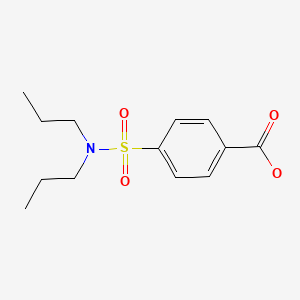Attribution Statement: LactMed is a registered trademark of the U.S. Department of Health and Human Services.
NCBI Bookshelf. A service of the National Library of Medicine, National Institutes of Health.
Drugs and Lactation Database (LactMed®) [Internet]. Bethesda (MD): National Institute of Child Health and Human Development; 2006-.
CASRN: 57-66-9

Drug Levels and Effects
Summary of Use during Lactation
Limited information indicates that maternal doses of probenecid up to 2 grams daily produce low levels in milk and would not be expected to cause any adverse effects in breastfed infants, especially if the infant is older than 2 months. In animal studies, probenecid increased the breastmilk excretion of cimetidine, possible via an interaction with an active transport mechanism in the breast.[1] The implications of enhanced excretion of drugs given with probenecid for nursing mothers and their infants has not been studied; however, only a few drugs are known to undergo active transport into breastmilk.
Drug Levels
Maternal Levels. A woman was given probenecid 500 mg orally 4 times daily to enhance cephalexin serum levels. After 16 days of therapy at 4.5 weeks postpartum, 12 samples of breastmilk (6 pairs of fore- and hindmilk) were collected over a 16-hour period. The average concentration of probenecid in milk was 964 mcg/L, corresponding to an infant dosage of 145 mcg/kg daily and 0.7% of the maternal weight-adjusted dosage.[2]
Infant Levels. Relevant published information was not found as of the revision date.
Effects in Breastfed Infants
A woman with mastitis received 3 days of intravenous cephalothin, followed by 16 days of probenecid 500 mg and cephalexin 500 mg 4 times daily for 16 days. Her infant developed green liquid stools, severe diarrhea, discomfort and crying. The authors judged the effects to be probably related to the cephalothin and cephalexin in milk rather than the probenecid.[2]
Effects on Lactation and Breastmilk
Relevant published information was not found as of the revision date.
References
- 1.
- Gerk PM, Oo CY, Paxton EW, et al. Interactions between cimetidine, nitrofurantoin, and probenecid active transport into rat milk. J Pharmacol Exp Ther. 2001;296:175–80. [PubMed: 11123378]
- 2.
- Ilett KF, Hackett LP, Ingle B, et al. Transfer of probenecid and cephalexin into breast milk. Ann Pharmacother. 2006;40:986–9. [PubMed: 16551765]
Substance Identification
Substance Name
Probenecid
CAS Registry Number
57-66-9
Drug Class
Breast Feeding
Lactation
Antigout Agents
Gout Suppressants
Sulfonamides
Uricosuric Agents
Disclaimer: Information presented in this database is not meant as a substitute for professional judgment. You should consult your healthcare provider for breastfeeding advice related to your particular situation. The U.S. government does not warrant or assume any liability or responsibility for the accuracy or completeness of the information on this Site.
- User and Medical Advice Disclaimer
- Drugs and Lactation Database (LactMed) - Record Format
- LactMed - Database Creation and Peer Review Process
- Fact Sheet. Drugs and Lactation Database (LactMed)
- Drugs and Lactation Database (LactMed) - Glossary
- LactMed Selected References
- Drugs and Lactation Database (LactMed) - About Dietary Supplements
- Breastfeeding Links
- PubChem SubstanceRelated PubChem Substances
- PubMedLinks to PubMed
- NTP Toxicology and Carcinogenesis Studies of Probenecid (CAS No. 57-66-9) in F344/N Rats and B6C3F1 (Gavage Studies).[Natl Toxicol Program Tech Rep ...]NTP Toxicology and Carcinogenesis Studies of Probenecid (CAS No. 57-66-9) in F344/N Rats and B6C3F1 (Gavage Studies).National Toxicology Program. Natl Toxicol Program Tech Rep Ser. 1991 Sep; 395:1-215.
- Review Pyrimethamine.[Drugs and Lactation Database (...]Review Pyrimethamine.. Drugs and Lactation Database (LactMed®). 2006
- Review Cycloserine.[Drugs and Lactation Database (...]Review Cycloserine.. Drugs and Lactation Database (LactMed®). 2006
- Review Pyrazinamide.[Drugs and Lactation Database (...]Review Pyrazinamide.. Drugs and Lactation Database (LactMed®). 2006
- Review Nalidixic Acid.[Drugs and Lactation Database (...]Review Nalidixic Acid.. Drugs and Lactation Database (LactMed®). 2006
- Probenecid - Drugs and Lactation Database (LactMed®)Probenecid - Drugs and Lactation Database (LactMed®)
- PLB1 [Oryctolagus cuniculus]PLB1 [Oryctolagus cuniculus]Gene ID:100009309Gene
Your browsing activity is empty.
Activity recording is turned off.
See more...
